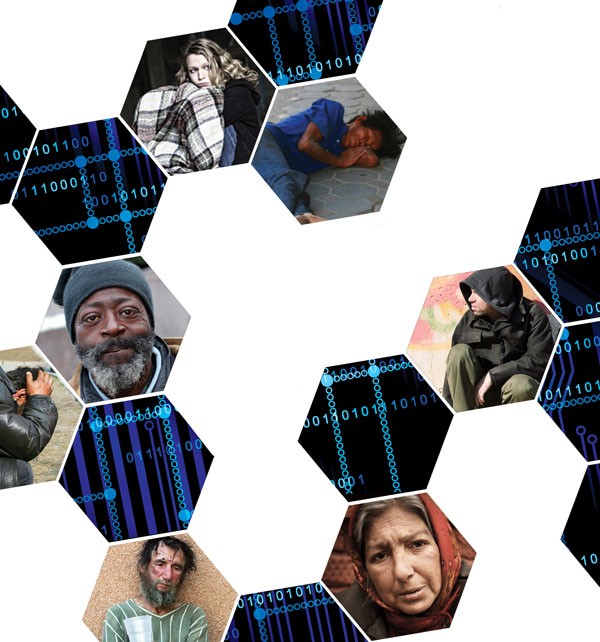There’s no such thing as a good day to be homeless. But for those living on the streets of Orlando last month, there were certainly worse days than Dec. 10, when the old Amway Arena hosted a fair offering a plethora of services addressing every ache, pain and trauma of the homeless experience.
At the arena that day, one could receive or arrange: a complete physical exam, a haircut from students of the Paul Mitchell school, an HIV test, a gift bag of toiletries (replete with towel and underwear), rent assistance, a birth certificate, an ID card, legal counsel, food stamps, mental health and drug abuse counseling and even a cell phone. Those with dogs could drop them off with a pet-sitter; those with bicycles could leave them with an attendant. Free food included hot dogs, hamburgers, potato chips and cookies. A wall of Gatorade ensured that no one had to drink water if they didn’t want to. And it was all free. Well, sort of.
The organizers wanted something in return: information. Before getting the perks and services, participants were asked to fill out a form from the Homeless Services Network of Central Florida requesting personal information like one’s veteran status, Social Security number and date of birth. The form also asked questions like “Have you ever been incarcerated?” and “Where did you stay last night?” The data in the 972 forms collected that day would later be input into a vast online database containing information on more than 86,000 people who have, at one point in the past eight years, utilized certain homeless services in Orange, Osceola and Seminole counties. People answering those questions for the first time would have new records created in the database; for those already in the system, their files would be updated to note that they attended a “Fairs/Exhibitions” service on Dec. 10.
This database, called Homeless Management Information Systems (HMIS), is not the outgrowth of an ambitious project by a local nonprofit, but rather, the slow fulfillment of a decade-old federal mandate to collect information on the homeless. Today, virtually all of the “communities” in the nation – whether it’s at the city, county or state level – have their own HMIS databases and are using them to enumerate and describe the homeless in their areas, as required by the department of Housing and Urban Development (HUD). But many communities – like the aforementioned three counties that comprise Central Florida – are also finding HMIS an excellent tool to make their own operations more efficient. The versatile database is now being customized by mental health clinics and courts, correctional facilities (and soon, the Veterans Administration), all of which are uploading their data to HUD as well. It’s a development that excites some, but worries others.
To its detractors, HMIS is an unnecessary hoarding of sensitive personal information that becomes more vulnerable as the database grows larger. But its proponents argue that it might be the most important tool in solving the nation’s problem of chronic homelessness. To them, the database needs more data to assist in providing better services. But to the vast majority of society, HMIS is just another forgettable acronym, unseen and unknown, existing as silently as the problem it was created to address.
It’s less than 24 hours before the big event at the Amway Arena, but despite the task at hand, the executive director of the Homeless Services Network of Central Florida, Cathy Jackson, takes an hour out of her day to join her co-worker, Joel Remigio, to speak with the Weekly about HMIS. Surprisingly, she says that no media outlets have inquired about the database, which is managed by Remigio.
“We’ve been waiting for someone to ask this arcane question for years,” Jackson says.
Their organization is the federally recognized “continuum of care” for Central Florida. As the name suggests, it strives to bridge the gaps between local homeless agencies, coordinating their efforts to improve the overall service to the economically disadvantaged in the area. The federal recognition means it’s the middleman between HUD and local agencies: money flows in one direction, and data flows in the other. HMIS was designed, in part, to make that process more efficient.

“It is the essential tool in managing an effective continuum of care,” Jackson says.
Yet it’s not a new tool by any measure. In October 2000 Congress called for the creation of a “management information system” for the “purposes of collecting unduplicated counts of homeless people and analyzing patterns of use of assistance.” That responsibility fell upon HUD, which manages many federal homeless-assistance programs and doles out more than a billion and a half dollars per year to homeless agencies nationwide.
The following year, HUD responded with a proposal, which it refined in 2004. The continuums of care would maintain one electronic database for all the agencies within their jurisdictions. Local agencies, after installing HMIS – provided by a variety of private software companies adhering to certain federal standards – would be required to collect 14 “universal data elements” about their clients, ranging from basics like name, race and Social Security number to more particular information like the ZIP code for an individual’s last permanent address. If an agency failed to get one of the data elements, another agency could add this information, given that a person has one unduplicated record within that community. Among other things, this would provide a clear path for a more accurate count of the homeless.
“If you [as a care provider] can see the number of chronically homeless individuals, then you can begin to design a response to confront the problem,” says HUD spokesman Brian Sullivan.
For a surprisingly long time, counting the homeless depended on crude and inaccurate methods. Before HMIS, the sole method used was “point-in-time” counts: On one designated night, armies of volunteers across the country fan out into the streets, call all the shelters, put the numbers together and send them to HUD. But that method of taking “snapshots” once a year (or every other year) doesn’t distinguish between the chronically homeless and those who are just in a temporary tough spot. According to HUD, the chronically homeless are about 15 percent of the people on the street at any given time, but they utilize 50 percent of homeless services, financially speaking.
That distinction became important enough for the federal government to take notice in the late ’70s and early ’80s, when the deinstitutionalization of the mentally ill, the loss of many single-resident housing units for individuals at risk of homelessness and cuts to social services combined to put more people than ever on the street. (Tellingly, it is difficult to find any numbers to describe the problem on a national level; still, there is a general consensus that urban homelessness increased starkly during this period.) In 1983, the first federal task force on homelessness was created, and in 1987, Congress passed the Homeless Assistance Act, which set aside federal money for homeless-assistance programs at the local level and gave birth to the continuums of care.
Yet at the turn of the century, the inability to count the homeless also made it difficult for Washington to measure the impact of those programs. Data on the homeless largely resided in the file cabinets of thousands of agencies; for every 365 days of homeless data collected by the agencies, there was only one day where the feds could take a peek. That’s where HMIS comes into play.
“The idea with HMIS is that over the course of a year, if you’re homeless, you’re more likely to touch the system,” Sullivan says. “For the first time, HMIS has allowed us to more fully appreciate the dynamic nature of homelessness in America.”
It’s been a slow climb for the database, but as HUD has drawn strings from coveted grants to HMIS usage, agencies have come along more quickly. Today, Central Florida has 32 different agencies and 179 individuals using the database. The information collected by the Homeless Services Network has real-world implications: by running the records on bed usage through a report in HMIS, for example, Remigio can judge that Central Florida’s emergency shelter and transitional housing bed coverage is “great,” while the number of permanent supportive-housing beds are “way low.”
Reports like these, Jackson says, help HUD allocate limited resources where they’re needed most. “People who are looking at the bucks – federal funding priorities – can quantitatively assess how many more beds we need,” she says.
Sullivan explains it in a larger context. “Data drives effective programming,” he says. “How would you solve a problem without fully understanding it?”
Anna Allen, a sprightly middle-aged woman, sits next to her fiance, Army veteran Joseph Long, at a picnic table at Lake Eola Park. They’re waiting for volunteers from the group Food Not Bombs to start serving the weekly free vegetarian dinners on this Wednesday evening, per their usual routine. The couple is homeless, but hasn’t heard of the database that their names may reside in. Allen, who says she was laid off from the Marriott Resort & Convention Center nine months ago, guesses it may be linked to a “no-hire list” she’s heard that the homeless are being put on. “I’ve heard that businesses can check who’s been to the Coalition [for the Homeless of Central Florida],” she says. The idea frustrates her fiance. “Losing everything we have is not a crime,” Long says.
While the couple waits for dinner, Food Not Bombs organizer Ben Markeson snaps photos of an unmanned truck that has been parked in a nearby cul-de-sac with its hazard lights on for the past 15 minutes. He’s hoping to demonstrate that the city has a double standard when it comes to applying the law to the homeless – a few weeks prior, police had given a parking ticket to a Food Not Bombs volunteer who had stopped her van momentarily to unload food for the regular sharing. “Basically, the city doesn’t want homeless people anywhere in Orlando,” Markeson says.
Though Allen hasn’t been in town long enough to make that judgment – she came from Ft. Lauderdale only a year ago – news of the database, to her, is another piece of evidence that the homeless are “stigmatized.”
That notion is one reason Sue Watlov Phillips, treasurer for the National Coalition for the Homeless, is a vocal opponent of HMIS. “If you put any one of us into the HMIS system, there’d be a lot of similarity between everybody,” she says. Phillips invokes her field of expertise – psychology – to prove her point, saying that fully half of Americans suffer from some sort of “chemical” or mental disorder. “The only difference is that you and I have enough money to afford a home, and the folks in the HMIS system do not,” she says. “All of us have issues.”
Her concerns about the homeless being singled out are shared by prominent civil liberties groups such as the American Civil Liberties Union, the Electronic Privacy Information Center and the Center for Democracy & Technology. In 2003, these organizations sent a letter to HUD stating that HMIS would “create a system of tracking similar to those imposed on individuals convicted of crimes” and with that, brought “unreasonable security risks” to the homeless. “When information is aggregated in a single place,” the letter says, “it becomes more valuable to malicious actors, and is more likely to be attacked.”
But why would anyone be interested in a homeless person’s information?
“If you consider identify theft in the financial realm, [the homeless are] not the primary targets,” says Jay Foley, executive director of the nonprofit Identity Theft Resource Center. “But when you consider it in the realm of employment, criminal activity or governmental benefits, it’s a target-rich environment.”
Recently, identity-theft scams targeting the homeless have been reported in Kentucky, California and Washington, baiting the homeless with anywhere between $5 and $850 for their personal information. “We just worry that it’s going on all across the country,” Foley says.
Foley says he doesn’t oppose the idea of a homeless database, provided that security measures are sound. And Jackson, Remigio and Sullivan all argue forcefully that this is the case with HMIS.

According to Josh Johnson, vice president of customer relations at Bowman Systems, which provides the ServicePoint software for the Central Florida HMIS system, the security measures of any HMIS database are similar to those found on the websites of major banks. All HMIS systems require a unique username and password to login and feature a “secure sockets layer” which encrypts data so that the user and the website are communicating in the same “language,” so to speak, but one that a hacker would not understand. Optional additional security measures are limited login attempts, access given to only specific computers and even more layers of encryption. “Anything you submit ‘over the wire’ – over the Internet – you want to be secured,” Johnson says. “[And] security continues to be our number one priority.” (Bowman Systems says it controls 70 percent of the HMIS software market, but declines to translate that into a dollar figure. In 2009, Florida received more than $2.3 million from HUD for HMIS databases across the state. Central Florida’s system received $124,388.)
Here in Central Florida, the database is a complex, multi-layered system of permissions that looks different to various users. All agencies can see the “universal data elements” on a client, but may be prohibited from seeing some of the “program-specific data elements” such as health history. Shelters like Coalition for the Homeless of Central Florida, for example, are not able to see if a client has AIDS, because that information has no bearing on how they provide services. With HMIS, it’s possible for two people working at adjoining desks to see the same file differently. “We have really fine control of what you can share in this system,” Remigio says.
According to Sullivan, the system in Central Florida has no link whatsoever to the hundreds of other HMIS databases across the country. “This is a local tool,” he says. “There’s no big mainframe in Washington.”
The homeless themselves have the right to view or modify their files, and they can refuse to give out their information. But that practically never happens, say Jackson and Remigio, especially considering that the agencies themselves require some basic information, regardless of HMIS standards. Another possible reason for the lack of resistance is that express consent is not required to input the information. Rather, HUD allows for inferred consent as long as a privacy notice is posted within sight in an agency’s intake area. This notice need not refer to HMIS by name, nor describe the nature of the database, but only that data is being collected and may be shared and/or used. “We assume that you agree to allow us to collect information and to use or disclose it as described in this notice,” reads the policy of the Homeless Services Network of Central Florida.
At its Dec. 10 event, that policy was printed on one page and taped to the fold-out tables hosting the intake interviews used to fill the forms which would later be entered into the database. The Weekly did not notice the privacy policy until an intake volunteer brushed aside a smattering of applications, forms and brochures to reveal it.
That revelation wasn’t extended to Chris, a 53-year-old homeless man from Trinidad who declined to give his last name to a reporter when interviewed at the Food Not Bombs weekly meal. While finishing his second over-ripe banana, he says that in his two years of homelessness in Orlando, he has never been arrested nor spent one night in a shelter. “I have no record at all,” he says assuredly.
When asked if he attended a large event last month at the old Amway Arena, he says yes – he remembers going mostly for the free food.
When informed that, in all likelihood, he now had an electronic record, he is silent for a couple of seconds. “They didn’t say I’d be in a database,” he says. “They just handed me a form and said to fill it out.”
Though HMIS was primarily conceived to collect and share information with the federal government, today’s HMIS systems are actually robust case-management programs, allowing users to scan documents into files, create “care plans” for clients and (most compellingly) share client profiles with other agencies. This is one reason the system has won some very devoted supporters, not least among them the area’s Housing Opportunities for Persons with AIDS (HOPWA) agencies.
Philip Toal, senior director of one of those programs, Anchor, calls HMIS a “godsend.” Before the database, he says, clients had to wait hours – sometimes days – to be provided any services. In the pre-HMIS era, a client would have to fill out a lengthy application, which would then be faxed to the seven other HOPWA agencies to ensure that the client was not “double dipping” on limited federal dollars or abandoning a plan already in progress with another program. Each of those agencies then had to check for that person’s name in their own files – which could have been misplaced or locked in a counselor’s office during a confidential session. Toal says the process sometimes took so long that some were literally left out in the cold. “It was possible that they were perfectly eligible, but we didn’t have the information we needed because of the antiquated system we were using,” he says. “Now, I can get you into a warm bed tonight.”
Sharing data through HMIS isn’t a privilege limited to just homeless agencies. This month, the Orange County Corrections Department will start feeding information on inmates who are 45 days from release and participating in re-entry programs into the Central Florida HMIS. A similar system already exists in Miami, where the 11th Judicial Circuit Criminal Mental Health Project uses HMIS to make sure that those diagnosed as mentally ill and finishing jail terms don’t get caught up in a vicious cycle of incarceration. “If we have a person getting out of jail today, we will make sure that they have a place to live and that they can get connected to treatment,” says project director Cindy Schwartz, who calls HMIS “very helpful.”
It should be noted that sharing homeless peoples’ data between agencies was never mentioned in the original Congressional mandate for the system, which only called for a one-way transaction of data with the federal government. Yet HUD had a grander vision for HMIS, and Congress went along with it. Today, HUD encourages agencies to think big – in fact, the Miami project received a “National Visionary Award” from HUD in 2006 for its inventive use of the system.
“If you’re trying to grapple with an area-wide problem, you need everybody at the table,” HUD’s Brian Sullivan explains.
But it’s this expansion of HMIS into new frontiers that most worries John Morris, general counsel for the Center for Democracy and Technology. He characterizes the database as entering “mission creep” – a term defined in the dictionary as “the gradual broadening of the original objectives of a mission or organization,” usually used in a negative context.
Morris says that as the database’s users increase, so does the risk of insider data leaks. That there hasn’t been a documented HMIS security breach doesn’t reassure him any. “Every data breach that we’ve had in this country was preceded by a big chunk of time when there wasn’t a data breach,” he says.
The “human factor” also worries Bowman Systems’ Johnson. Despite all the security measures in place, he says, he can’t stop a user from giving someone else their ID and password, nor from printing out a report and leaving it out for unauthorized eyes to see. “Technically, there are things in place to secure the data,” he says. “But there are other things we have no control over.”
Since individual agencies can only see a limited amount of shared data, and since HUD and Congress are only interested in aggregate numbers, the only individuals with unrestricted access to all the data on more than 86,000 people in Central Florida are Remigio, his assistant and a handful of administrators at Bowman Systems. Remigio is nonchalant about the privilege of being one of the few with unfettered access. “There’s not a database in the world that’s not like that,” he says.
But he also is sure to stress his professional values: “People come to us at their lowest point,” he says. “A way to maintain their dignity is to respect their privacy.”
Jackson demonstrates their adherence to this principle by an example in which there’s a temptation to abandon it: “Frequently, we have Mom call from Massachusetts … she knows her adult son is here in Orlando, and she’s lost track of him, she knows he’s homeless, and he’s schizophrenic. [She asks:] ‘Could we please find him and tell him that she’ll buy a ticket for him to come home?’ ... That’s a good reason to go find where a client is. But we still don’t do it.”
HUD privacy standards say that police may access a client’s data if the safety of the public depends on it. Jackson says that her organization has only been asked once for access to an individual record in the database, to which she replied that she’d have to be served with a subpoena. (She won’t say who asked or whether a subpoena was actually served.)
Given the increasing prominence of data leaks, insider theft and cyberattacks in the news, it’s difficult to argue that Internet-based data banks are completely secure, even with principled folks holding the keys. Jim Wright, a UCF sociology professor who utilizes aggregate reports from HMIS for academic research, acknowledges this notion. “Nothing’s airtight,” he says. “I mean, we’ve got 14 year-old kids hacking into the FBI.”
Just as the Weekly’s interest in HMIS takes Jackson and Remigio by surprise, so too does the criticism of it. They’ve heard none of it, they say, and they regard it more as a curiosity or an annoyance than a serious threat. As far as HMIS goes, it seems they’ve got more pressing matters to worry about.
For instance, other than the HOPWA agencies and two other outreach organizations, none of the other agencies in the area are sharing more than the bare minimum with each other. Two of the biggest agencies in the area, the Coalition for the Homeless and the Salvation Army, could benefit from having a more open system, for instance, by being able to instantly see how many beds the other agency has open and then refer clients to the other agency if their own are full. Yet neither group appears close to even entertaining the notion. “We just haven’t looked at sharing it yet,” says Muffet Robinson, director of communications for the Coalition for the Homeless of Central Florida. “It’s working fine for what we’re using it for right now.”
It’s a microcosm of the bigger challenge that lies ahead for the Homeless Services Network: getting organizations with “natural affinities” to work together. During the first quarter of this year, Jackson and Remigio plan to act as matchmakers, using the utility of HMIS as an icebreaker. “They all know each other, but to actually get them in a room and generate a better familiarity with each other will make them more willing to share information,” Remigio says.
Also soon to be on Remigio’s plate is a proposal by the Veterans Administration to copy homeless veterans’ data from VA databases into HMIS, which would help the Homeless Services Network and HUD get a more complete picture of homeless veterans in the area.
Remigio says this is part of HUD’s push to make HMIS the community’s “central resource on homeless data.” This leads to the prevailing argument for the growth of HMIS: As more agencies come into contact with the homeless and enter their information into the database, the more accurate and comprehensive the picture of homelessness in the region is. To Remigio and Jackson, expansion of the database is not only good, but necessary.
“If you look at it from a 30,000-foot level, the ideal environment would be to have any church, any private foundation or any nonprofit who is serving homeless people entering information into HMIS, and ultimately, being able to manage client resources electronically,” Jackson says. “That’s the ideal that we’re trying to meet.”
It’s a goal that’s either noble or unsettling, depending on who’s listening. But wherever one stands, it’s hard to disagree with Sullivan.
“The applications of this data,” he says, “are infinite.”


















